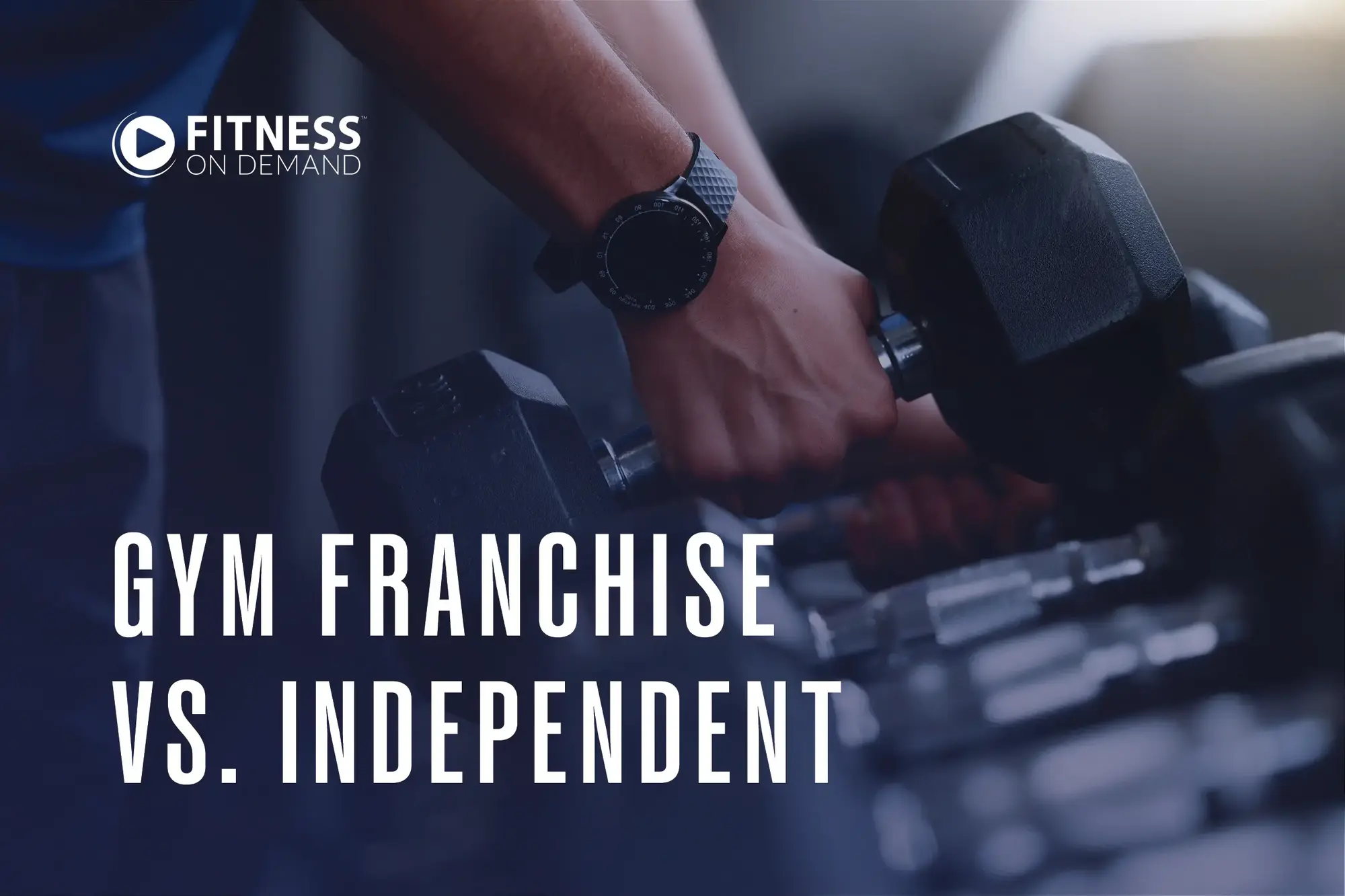Thinking about launching your own fitness business? Choosing between a gym franchise and going independent is one of the first big decisions you'll make. Both paths offer real potential — but they come with very different challenges. Whether you're planning to start your own gym business from scratch or buy into a proven system, your choice will shape how much support you get, how much control you have, and how your day-to-day looks.

It helps to understand the real-world trade-offs between structure and autonomy, support and flexibility, and risk and reward. And how technology — from virtual fitness to digital signage — can help level the field, no matter which route you take.
Gym Franchise vs. Independent Ownership: What's the Real Difference?
When it comes to fitness center ownership, the difference between a gym franchise vs. an independent model comes down to control, support, and brand identity.
5 Retention Hacks
Explore these five practical and innovative strategies to increase retention, boost engagement, and embrace personalization. Download our eBook to get started!
A gym franchise gives you a plug-and-play business model. You pay for a recognizable name, tested systems, and built-in support. Gym franchises come with branding, training, and access to tools that can help you grow.
Independent gyms, on the other hand, give you total freedom. You choose the look, the vibe, the programming, and the pricing. But with that freedom comes more responsibility — and more risk. You're not just running a gym, you're building a brand.
This also ties into the difference between a corporate gym and a franchise gym. Corporate gyms are owned and operated by a central company, with no individual ownership. Franchises are owned by individual operators but must follow the parent brand’s rules. Independents, meanwhile, answer only to themselves.
Each path has pros and cons. It really depends on your style, your risk tolerance, and how hands-on you want to be.
Startup Costs and Ongoing Fees: What You’ll Spend
A franchise gym typically requires a significant upfront investment. The average cost of buying a franchise is $80,000, but the total cost depends on several factors, such as the brand, size, and location. You’ll also pay royalties and possibly a percentage of monthly revenue and other fees. Some of the best gym franchises also require ongoing contributions to national marketing funds.
With independent gyms, startup costs can vary widely based on your location, gym design choices, and equipment needs. You’re not paying franchise fees, but you will need to invest time and money into website development, branding, and operations. Setting up small-scale gyms typically costs between $250,000 and $500,000, while the total costs of medium to large-scale gyms can go over $1.5 million and $5 million.
Independent owners can, however, tailor monthly rent, equipment, permits, and marketing to their specific concept to lower the initial startup costs. You keep more of the gym revenue, but you're also spending more time setting things up.
Whether you franchise or go independent, you’ll need a smart approach to gym budgeting. Hidden gym costs can creep in quickly, especially when it comes to staffing, insurance, and maintenance.
Branding and Creative Control: How Much Say Do You Have?
Franchise ownership comes with established branding guidelines. Logos, colors, class formats — even social media tone — are often standardized as franchise resources. This helps maintain consistency across locations and helps to build trust with customers.
Independent gym owners, on the other hand, have full creative control. Want to focus on functional fitness or host a local wellness event? Go for it. You set the tone, choose the equipment, and create the member experience from top to bottom.
If branding is part of your vision, independent gym ownership gives you room to bring that to life. But if you’d rather not reinvent the wheel, a franchise’s brand identity can be a huge advantage.
This is where tech tools like branded apps and digital signage can help independents look polished and professional, without hiring a marketing agency.
Operational Support and Training: Who’s Helping You Succeed?
When you own a gym franchise, you usually get onboarding support, operations manuals, and access to training for you and your team. Having that amount of structure in place can make fitness center management more straightforward. This can be an attractive benefit if you're new to the industry.
Independent gym owners have to build that support system themselves. You may need to hire consultants or spend more time researching gym operations. Still, you have the freedom to design systems that work best for your specific members and staff.
Today, digital tools like scheduling software and member management systems can help both models streamline operations. Whether you’re building from scratch or adding tech to a franchise setup, automation is changing the game.
Marketing and Lead Generation: Who Brings in the Customers?
Franchises often offer built-in gym marketing strategies: national campaigns, branded content, and lead-generation platforms. You may also get access to gym-specific customer relationship management (CRM) software and templates to simplify your marketing promotions.
Independent gyms have to develop marketing plans themselves. That means learning the ropes of local advertising, email marketing, SEO, and social media. But it also means you get to shape your message, connect with your community, and try creative strategies.
Digital signage, branded apps, and targeted messaging can help independent gym owners compete on visibility. Even a small local gym can create a strong digital presence using the right tools.
Revenue Potential and Risk Management
When you're looking at franchise pros and cons, it’s important to think about your startup costs up front. You’ll also want to consider whether the long-term revenue model fits your goals and how much risk you’re comfortable taking on.
With a franchise, your earning potential is often capped by ongoing royalties and required pricing structures. Still, the risk is often lower since you’re operating within a proven gym business model.
Independent owners keep every dollar they earn. But revenue is less predictable, especially early on. You need to be prepared for slower months and invest in retention tools that will keep your pipeline full.
Growth Potential and Expansion Paths
With a fitness franchise, your gym’s growth would usually follow the brand’s expansion model. You might choose to open new locations under the same name, using the same systems. That can make scaling faster and more predictable.
Independent owners have more flexibility but fewer built-in systems. You choose when and how to grow—whether that means expanding your current space, opening a second location, or licensing your own brand.
The trade-off here is structure vs. freedom. Franchises provide a roadmap, while independent gyms let you build your own.
Day-to-Day Flexibility and Autonomy
Franchise gym owners usually need to follow set guidelines for everything from class schedules to staff uniforms. That consistency helps build trust, but can limit your ability to experiment.
Independent gyms have full flexibility. Want to run pop-up bootcamps or tweak your hours during summer? You decide. This autonomy lets you adapt quickly to member feedback or market trends.
That said, more freedom also means more daily decision-making. You’re steering the ship solo, which can be empowering or overwhelming, depending on your style.
Technology That Can Level the Playing Field
Tech is changing the rules. Independent gyms can now access digital tools that were once only available to big brands.
Scheduling platforms let you automate bookings and class management. Branded apps offer a seamless member experience, from check-in to content delivery. On-demand fitness libraries keep members engaged outside of gym hours. Even digital signage can give your gym a modern, high-end feel without franchise-level investment.
For franchise gyms, tech isn’t just a bonus — it’s a brand asset. Many of the best gym franchises are integrating custom fitness programming solutions, challenge-based classes, and branded content into their core offering. These digital enhancements support member retention and elevate the overall experience.
What Independent Owners Can Do to Stay Competitive
If you choose the independent route, you’re not going it alone. The right tech stack can put you toe-to-toe with bigger names.
- Use branded apps to engage members with push notifications, habit tracking, and reward systems.
- Offer on-demand fitness content so members can work out anytime, anywhere.
- Automate key parts of your operations, like onboarding, scheduling, and retention strategies.
The result? Less time spent on admin, more time spent building community.
How Franchises Can Maximize Their Tech Stack
Just because your gym comes with built-in tools doesn’t mean you can’t take things further.
Franchises can upgrade their experience with custom digital content — like branded workout videos, guided meditation sessions, or recovery programs. Add challenge-based programming to increase engagement. Use signage and kiosks to promote upcoming classes or events.
Even within structured systems, there’s plenty of room to make your franchise location stand out.
Fitness On Demand: A Digital Edge for Any Gym Model
Whether you're operating under a national banner or building your brand from scratch, Fitness On Demand helps you deliver a modern member experience.
- Offer a custom-branded app that feels uniquely yours.
- Access a robust on-demand class library to round out your fitness programming.
- Use digital signage and smart scheduling tools to keep things running smoothly.
- Track engagement with usage analytics and adjust your strategy as needed.
Want to see how this could work in your gym? Request a demo today and discover how Fitness On Demand can fit your model — franchise or independent.
With the right digital tools and a clear strategy, there’s no one-size-fits-all answer. Whether you’re looking to open a gym with brand support or start a gym on your own terms, the path to success is wide open.

Author
Todd Wiginton
Todd Wiginton is a seasoned fitness professional with over a decade of experience in the industry, currently serving as the Sr. Director of Operations at Fitness On Demand. His career, marked by roles such as Personal Training Manager and Strength and Conditioning Coach, showcases his dedication to fostering personal and professional growth in ever-changing environments.
